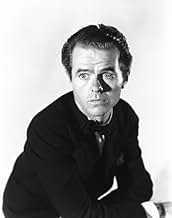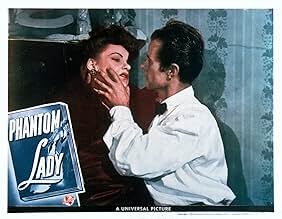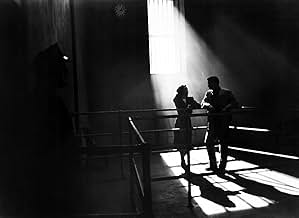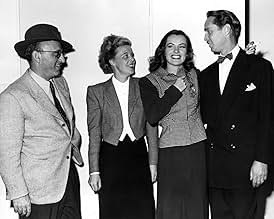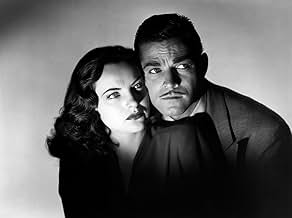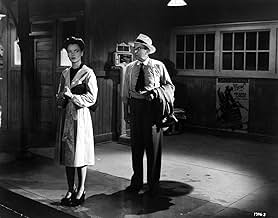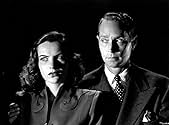AVALIAÇÃO DA IMDb
7,2/10
6,3 mil
SUA AVALIAÇÃO
Adicionar um enredo no seu idiomaA devoted secretary risks her life to try to find the elusive woman who may prove her boss didn't murder his selfish wife.A devoted secretary risks her life to try to find the elusive woman who may prove her boss didn't murder his selfish wife.A devoted secretary risks her life to try to find the elusive woman who may prove her boss didn't murder his selfish wife.
- Direção
- Roteiristas
- Artistas
Aurora Miranda
- Estela Monteiro
- (as Aurora)
Milburn Stone
- District Attorney
- (narração)
Harry Adams
- Courtroom Spectator
- (não creditado)
Robert Bain
- Guitarist
- (não creditado)
Joan Bayley
- Dancer
- (não creditado)
Brandon Beach
- Theatre Party Guest
- (não creditado)
Brooks Benedict
- Theatre Party Guest
- (não creditado)
- Direção
- Roteiristas
- Elenco e equipe completos
- Produção, bilheteria e muito mais no IMDbPro
Avaliações em destaque
Phantom Lady is quintessential Film Noir and a must-see for anyone who appreciates the genre. The film is not, nor does it aspire to be, a whodunit with an airtight plot, or a mystery-thriller that ends with an inconceivable twist as in the original novel. If that is what you want or expect, this is probably not your cup of tea. Although many great films considered part of the noir genre may include some of these elements, that's not what film noir is all about.
Film Noir is almost synonymous with Cornell Woolrich (William Irish), the author of the novel Phantom Lady. His novels and short stories are the source of an amazing number of screenplays and teleplays, including several noir and non-noir classics such as Hitchcock's Rear Window.
As a writer and persona, Woolrich was a uniquely noirish sort of guy. In fact, he wrote a series of six "Black" novels, all have been adapted to the screen or TV at least once, and some multiple times. Obviously, noir means black, and these black novels inspire great noir films.
Many Woolrich stories, Phantom Lady is one, revolve around impossible crimes. As sinister forces close in, his protagonists are powerless do anything but follow some diabolical labyrinth that defies understanding. No wonder his work is a perfect fit for film noir, which takes place in its own dark universe, where characters struggle against powerful and malevolent forces. Unfortunately, the nightmare scenarios created by Woolrich, enhanced by his own inimitable style of description, often seem to get lost in translation when brought to the silver screen. Although most of the films are very good, these adaptations tend to be very different from their literary source.
Not so with Phantom Lady – up to a point. Although details may vary, director Robert Siodmak cleverly and adroitly uses dazzling Expressionist visuals and quirky character performances to emulate the dreamlike quality of a Woolrich story. A good example is the incredible scene where Elisha Cook Jr. drums up the sexual overtones for Ella Raines.
Since our psychotic mastermind is revealed early on, there is no who-done-it mystery to distract the audience. The revelation allows a brilliant means of reworking the story into a tight and infinitely more interesting screenplay. Woolrich's original story follows a different approach, not confirming the killer until the end. Obviously, some treatments work better as a novel than a movie.
Often over-shadowed in the movies which he appears, this time Franchot Tone fits so perfectly into the role of Jack Marlow that we are captivated by his machinations, wondering where it will all end. All of the other characters are great and true to form as well. Raines is exceptionally strong in her portrayal of the somewhat naive love-struck secretary who won't give up.
True to a Woolrich novel, the genius of the film is in the telling of the story; more important than structure or even the ending. Although the outcome is the same, the ending is much different in the novel. Also, after the killer is revealed in the original story, there are 16 long pages, explaining every detail of every plot twist. Unfortunately, this approach is anticlimactic, and would never work as a film. Nevertheless, Siodmak is able to present a more convincing story with almost no explanation.
Any screen adaptation of a Woolrich story is always in jeopardy of being swallowed up by massive plot holes. After all, part of the charm of a Cornell Woolrich story is that you never really know if you dealing with reality, or trapped in a drug and alcohol induced nightmare.
In Phantom Lady, a character reveals, " I'd been blazing a reefer already before it happened, and you know what that does to you." Woolrich certainly did know, and much of his literature is obviously inspired by mind-bending experiences. If a screenwriter and director can artfully breach the massive plot chasms of an original Woolrich story, yet still preserve the beauty as in Phantom Lady, the film becomes a feast for any Film Noir fanatic.
Film Noir is almost synonymous with Cornell Woolrich (William Irish), the author of the novel Phantom Lady. His novels and short stories are the source of an amazing number of screenplays and teleplays, including several noir and non-noir classics such as Hitchcock's Rear Window.
As a writer and persona, Woolrich was a uniquely noirish sort of guy. In fact, he wrote a series of six "Black" novels, all have been adapted to the screen or TV at least once, and some multiple times. Obviously, noir means black, and these black novels inspire great noir films.
Many Woolrich stories, Phantom Lady is one, revolve around impossible crimes. As sinister forces close in, his protagonists are powerless do anything but follow some diabolical labyrinth that defies understanding. No wonder his work is a perfect fit for film noir, which takes place in its own dark universe, where characters struggle against powerful and malevolent forces. Unfortunately, the nightmare scenarios created by Woolrich, enhanced by his own inimitable style of description, often seem to get lost in translation when brought to the silver screen. Although most of the films are very good, these adaptations tend to be very different from their literary source.
Not so with Phantom Lady – up to a point. Although details may vary, director Robert Siodmak cleverly and adroitly uses dazzling Expressionist visuals and quirky character performances to emulate the dreamlike quality of a Woolrich story. A good example is the incredible scene where Elisha Cook Jr. drums up the sexual overtones for Ella Raines.
Since our psychotic mastermind is revealed early on, there is no who-done-it mystery to distract the audience. The revelation allows a brilliant means of reworking the story into a tight and infinitely more interesting screenplay. Woolrich's original story follows a different approach, not confirming the killer until the end. Obviously, some treatments work better as a novel than a movie.
Often over-shadowed in the movies which he appears, this time Franchot Tone fits so perfectly into the role of Jack Marlow that we are captivated by his machinations, wondering where it will all end. All of the other characters are great and true to form as well. Raines is exceptionally strong in her portrayal of the somewhat naive love-struck secretary who won't give up.
True to a Woolrich novel, the genius of the film is in the telling of the story; more important than structure or even the ending. Although the outcome is the same, the ending is much different in the novel. Also, after the killer is revealed in the original story, there are 16 long pages, explaining every detail of every plot twist. Unfortunately, this approach is anticlimactic, and would never work as a film. Nevertheless, Siodmak is able to present a more convincing story with almost no explanation.
Any screen adaptation of a Woolrich story is always in jeopardy of being swallowed up by massive plot holes. After all, part of the charm of a Cornell Woolrich story is that you never really know if you dealing with reality, or trapped in a drug and alcohol induced nightmare.
In Phantom Lady, a character reveals, " I'd been blazing a reefer already before it happened, and you know what that does to you." Woolrich certainly did know, and much of his literature is obviously inspired by mind-bending experiences. If a screenwriter and director can artfully breach the massive plot chasms of an original Woolrich story, yet still preserve the beauty as in Phantom Lady, the film becomes a feast for any Film Noir fanatic.
I found this film noir to be odd in that the beginning and the end were both lousy but the middle part was excellent. The "lousy" parts are such because they drag on and are simply boring when they don't have to be. The immediate opening scenes are fine, showing an innocent man, "Scott Henderson" (Alan Curtis) being charged and found guilty of a murder he didn't commit....but then almost nothing happens for the next 20 minutes.
Then comes the good part when Henderson's secretary "Carol 'Kansas' Richmond" (Ella Raines) gets involved, taking it upon herself to find the missing woman who could prove that her boss was innocent. During her pursuit we meet a couple of very interesting characters and we see some outstanding film-noir photography.
The most interesting character, "Cliff," was played by film noir regular Elisha Cook Jr. He has one scene in which he takes Raines to a local warehouse-type room where his jazz band is practicing. Cook then shows off with this drum playing and it is so frenetic, so bizarre that it is almost shocking to watch. You have to see it, to appreciate it. It's a small, insignificant scene but very memorable. A few other minor characters are a bit strange, too.
Thomas Gomez plays a cop ("Inspector Burgess") who winds up helping Raines a bit, and he's good to watch, too.In the end, Raines discovers what's up and is in peril herself. That scene has suspense but is too drawn out. It's like, "okay, already.....let's go on with it!"
Then comes the good part when Henderson's secretary "Carol 'Kansas' Richmond" (Ella Raines) gets involved, taking it upon herself to find the missing woman who could prove that her boss was innocent. During her pursuit we meet a couple of very interesting characters and we see some outstanding film-noir photography.
The most interesting character, "Cliff," was played by film noir regular Elisha Cook Jr. He has one scene in which he takes Raines to a local warehouse-type room where his jazz band is practicing. Cook then shows off with this drum playing and it is so frenetic, so bizarre that it is almost shocking to watch. You have to see it, to appreciate it. It's a small, insignificant scene but very memorable. A few other minor characters are a bit strange, too.
Thomas Gomez plays a cop ("Inspector Burgess") who winds up helping Raines a bit, and he's good to watch, too.In the end, Raines discovers what's up and is in peril herself. That scene has suspense but is too drawn out. It's like, "okay, already.....let's go on with it!"
This is a strange little movie.......a film noir with some good performances and some not so good. You often see this film on lists of noir classics but it raises the inevitable question....is it a classic or does it have just too many faults to raise it to the level of winners like "DOA", "The Big Sleep" or "Night and the City".
The premise is fairly good. A man can't prove his whereabouts when his wife is murdered and can only describe his alibi as an unknown woman wearing a rather distinctive hat The story follows the hero's secretary and a sympathetic policeman as they try to prove his innocence. Alan Curtis is a disaster as a gloomy, rather unlikeable man who pretty much gives up trying to find the real killer and becomes resigned to his fate. He doesn't put up much of a fight and his attitude doesn't help much. The lovely Ella Raines portrays the secretary who gets herself into some uncomfortable situations, especially with Elisha Cooke Jr as the drummer man with the plan. Plenty has been said about the drumming scene which somehow sneaked by the censors. It has to be seen to be believed.......whew!!
Franchot Tone plays the hero's best friend and I am still trying to figure out if his playing of that part was really good or really bad. The answer is probably "really bad". The role is against type for him and he overdoes it. He does have a great apartment though!
Fay Helm, playing the woman with the hat, is strangely attractive and is just right for the "phantom lady". Thomas Gomez, as the friendly cop, does his usual good job. So is this film worth watching?......yes. It has some plot holes but overall it is enjoyable. Give it a try.
The premise is fairly good. A man can't prove his whereabouts when his wife is murdered and can only describe his alibi as an unknown woman wearing a rather distinctive hat The story follows the hero's secretary and a sympathetic policeman as they try to prove his innocence. Alan Curtis is a disaster as a gloomy, rather unlikeable man who pretty much gives up trying to find the real killer and becomes resigned to his fate. He doesn't put up much of a fight and his attitude doesn't help much. The lovely Ella Raines portrays the secretary who gets herself into some uncomfortable situations, especially with Elisha Cooke Jr as the drummer man with the plan. Plenty has been said about the drumming scene which somehow sneaked by the censors. It has to be seen to be believed.......whew!!
Franchot Tone plays the hero's best friend and I am still trying to figure out if his playing of that part was really good or really bad. The answer is probably "really bad". The role is against type for him and he overdoes it. He does have a great apartment though!
Fay Helm, playing the woman with the hat, is strangely attractive and is just right for the "phantom lady". Thomas Gomez, as the friendly cop, does his usual good job. So is this film worth watching?......yes. It has some plot holes but overall it is enjoyable. Give it a try.
Robert Siodmak does a fabulous job with this B noir starring Ella Raines, Franchot Tone, and Alan Curtis. And he does it, I might add, without a lot of help from his male actors, i.e., Curtis and Tone. It's Raines all the way, a pretty, leggy actress who for one reason or another never reached the status of some of her "noir" counterparts.
Siodmak's use of sex, light, shadows, and music is truly remarkable as he tackles this genre. The shadows, lighting effects, and camera angles are all effective. But the highlight of the film takes place in a nightclub with a very sexual drum riff by Elisha Cook, egged on by an excited Raines. It's this scene that brings "Phantom Lady" into new territory.
Siodmak's commitment to the material is matched only by Raines, who gives a sincere performance as a woman in love trying to save her man. Franchot Tone phoned this one in. Alan Curtis didn't seem upset that he might die and didn't seem happy that he lived. And he never, except for a brief moment in prison, seemed to be in love with Raines.
The amusing thing about many of these films is that, as World War II progressed, interest in psychiatry deepened. But often the terms were used incorrectly in films such as "Possessed," "Spellbound," and "The Greatest Show on Earth." Tone is called paranoid by Thomas Gomez - Tone probably has some paranoia attached to his disorder, but he appears to be closer to a psychopath. In actuality, as evidenced by his headaches, he may have had a brain tumor pushing against his brain.
Phantom Lady doesn't have the greatest plot, but it's well worth watching.
Siodmak's use of sex, light, shadows, and music is truly remarkable as he tackles this genre. The shadows, lighting effects, and camera angles are all effective. But the highlight of the film takes place in a nightclub with a very sexual drum riff by Elisha Cook, egged on by an excited Raines. It's this scene that brings "Phantom Lady" into new territory.
Siodmak's commitment to the material is matched only by Raines, who gives a sincere performance as a woman in love trying to save her man. Franchot Tone phoned this one in. Alan Curtis didn't seem upset that he might die and didn't seem happy that he lived. And he never, except for a brief moment in prison, seemed to be in love with Raines.
The amusing thing about many of these films is that, as World War II progressed, interest in psychiatry deepened. But often the terms were used incorrectly in films such as "Possessed," "Spellbound," and "The Greatest Show on Earth." Tone is called paranoid by Thomas Gomez - Tone probably has some paranoia attached to his disorder, but he appears to be closer to a psychopath. In actuality, as evidenced by his headaches, he may have had a brain tumor pushing against his brain.
Phantom Lady doesn't have the greatest plot, but it's well worth watching.
I'll admit that I like a certain degree of plausibility in films. Thus, it was hard for me to totally embrace this movie after watching the scene in which the husband (Alan Curtis) comes home to his darkened apartment and calls out for his wife, wondering where she is,unaware that detectives were there waiting for him. It was obvious that Curtis expected the wife to be home, not to mention alive, yet the detectives never took this into consideration. If you strangled your spouse, would you return home later and call out for her? Besides, who could have tipped off the detectives that a murder had occurred? OK, if you get by these sore spots, you'll find a well-made film noir that is worth watching.
Você sabia?
- CuriosidadesThe elusive phantom lady being sought by Carol "Kansas" Richman (Ella Raines), is repeatedly referenced as "Miss Terry" (i.e., "mystery").
- Erros de gravaçãoCliff's (Elisha Cook Jr.) "drumming" at no time matches the drums on the soundtrack.
- Citações
Cliff: You and I are going to have fun tonight, Jeannie! You like jive?
Carol Richman: You bet! I'm a hep kitten!
- ConexõesFeatured in CSI: Investigação Criminal: A Night at the Movies (2003)
- Trilhas sonorasI'll Remember April
(uncredited)
Music by Gene de Paul
Lyrics by Patricia Johnston & Don Raye
[played during opening credits and throughout the movie]
Principais escolhas
Faça login para avaliar e ver a lista de recomendações personalizadas
- How long is Phantom Lady?Fornecido pela Alexa
Detalhes
- Data de lançamento
- País de origem
- Idiomas
- Também conhecido como
- La dama fantasma
- Locações de filme
- Empresa de produção
- Consulte mais créditos da empresa na IMDbPro
- Tempo de duração
- 1 h 27 min(87 min)
- Cor
- Proporção
- 1.33 : 1
Contribua para esta página
Sugerir uma alteração ou adicionar conteúdo ausente


